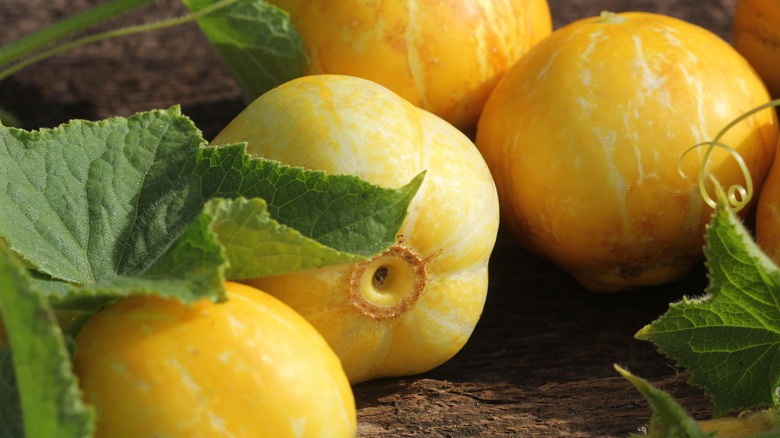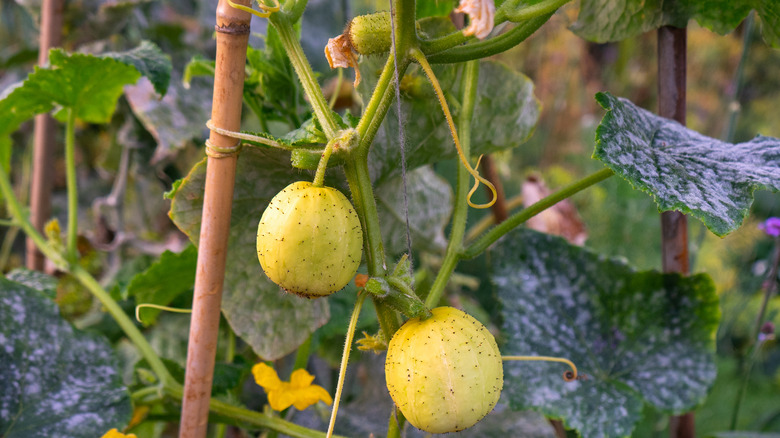How To Plant Lemon Cucumbers: The Unique Vegetable That's Surprisingly Easy-To-Grow
If you're looking for a new addition to your garden that will get the neighborhood talking, then look no further. Lemon cucumbers (Cucumis sativus 'Lemon') are a fun and exciting way to add variety to your garden and your kitchen. Native to India, these round vegetables first gained popularity in Australia before being introduced in America in the late 19th century where they have become a fan favorite in farmers markets. While they don't have a citrus taste, their sweet, fresh flavor makes them great for adding unique color to salads.
If you're eager to get your hands on these vegetables, their seeds can easily be sourced online and they are fairly easy to grow. In fact, they can be in a potted container or in the garden, making them a great option if you want to plant a vegetable garden in a small space. Hardy in USDA Zones 4 through 11, lemon cucumbers thrive in well-draining soil that is rich in nutrients to feed these hungry plants. Their seeds can be started indoors a couple of weeks before the last frost. Plant 2-3 seeds in groups, one inch deep into good quality potting soil and germinate them on a warm window sill for 10 days. Alternatively, you can sow your seeds outdoors if you're in a warmer climate when soil temperatures in your region have reached 60 degrees or more.
How to grow your own lemon cucumbers at home
Once your seedlings have germinated and started producing leaves that are 1-2 inches long, you can thin each plant out by cutting or pinching weaker, unwanted seedlings, leaving only one strong seedling to grow in each spot. Avoid pulling on the seedlings as that could damage the roots of your remaining seedling. When transplanting your lemon cucumbers into a larger container, be sure to use one that is large enough to see the plants through to maturity as cucumbers don't like a lot of root disturbance. You can transplant your lemon cucumbers into a potting container that is at least 5 gallons with drainage holes filled with well-draining potting mix and a handful of rich fertilizer. Plant them 12 to 24 inches apart so their vines have enough room to spread out while also enjoying good air circulation.
Like green cucumbers, lemon cucumbers can be allowed to sprawl on the ground or you can grow your cucumbers vertically against a trellis or another support structure. Growing cucumbers vertically allows gardeners to make the most out of their space while also protecting their crops from pests and diseases they would be exposed to if they grew on the ground. If you do end up choosing to use a trellis, be sure to put it in place when planting to train your plants while they're young. Grown in the right conditions, lemon cucumbers can reach maturity within a couple of months, growing 3 to 6 feet tall.
Caring for your lemon cucumbers
Lemon cucumbers are vulnerable to pests like aphids, spider mites, and cucumber beetles while also being susceptible to diseases like powdery mildew, anthracnose, and nutrient deficiencies. This can be avoided or remedied through the moderate use of fertilizers that are rich in nitrogen, phosphorus, and potassium as well as insecticidal soaps and bug sprays, such as a homemade neem oil spray to deter pests.
Regardless of whether you're growing your lemon cucumbers in containers or directly in the ground, these plants need consistent soil moisture while being careful not to waterlog them. Consider adding a two inch layer of mulch around the base of each plant to maintain soil moisture and temperatures once it starts getting warmer. A soaker hose is also a good idea to keep your plants' root zones adequately hydrated. Plants grown in a container, however, do require more frequent watering than those planted in the ground. You can also boost your plants' production by regularly harvesting ripe fruit to encourage repeat harvests throughout their season.


